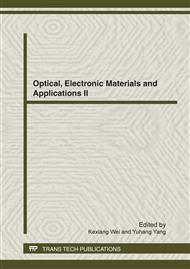p.3
p.9
p.14
p.19
p.23
p.29
p.33
p.37
p.43
A Novel Method for Pulse Integration in Radar-Probing System
Abstract:
In this paper, a novel method for pulse integration in radar-probing system is proposed to yield a low sidelobe response. According to m-sequence widely used in spread spectrum communication system, a bipolar pulse sequence is designed in this paper. At the receiving end, the envelop-detected signal is processed by a corresponding algorithm which dilutes the range sidelobe influence much. Because of the good autocorrelation and cross-correlation properties, waveforms yield a low sidelobe response and major lobe to side lobe ratio can reach 30dB or more, which is easy to satisfy the practical requirements. Simulation results show the good performance of the proposed approach. Furthermore, the approach is compatible to the conventional radars and can also be applied to the upgrade of radar.
Info:
Periodical:
Pages:
23-28
Citation:
Online since:
June 2012
Authors:
Price:
Сopyright:
© 2012 Trans Tech Publications Ltd. All Rights Reserved
Share:
Citation:


